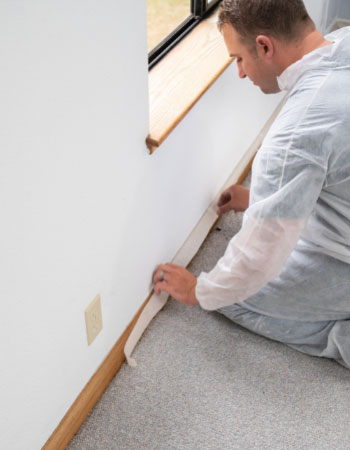The majority of homeowners who decide to do their own interior painting projects, will at some time encounter the problem of how to paint baseboards with carpet on the floor. Carpet is not forgiving when you get paint on it so the struggle is to get smooth even coats of paint on the baseboards and avoid getting any paint on the rug.
Our professional interior designers and painters told us that even professionals can have difficulties painting under these conditions. However, they did share some expert advice on how to paint trim near the carpet, and professional painting tips that you can use the next time this situation arises in your life.
Tips When Painting Baseboard with Carpet
Consider the Way the Room was Built

When you consider how to paint trim next to carpet the first thing you must ask yourself is what came first, the carpet or the trim board. Was the carpet already in place when the baseboards and trim were installed or were the baseboards established prior to the installation of the carpeting?
Carpet Before Trim
If the carpet in the room was in place before the trim in the room was installed then you are not going to be able to peel the carpet back to expose easy access to the trim. You either have to remove the boards, paint them, and then reinstall them, or you have to do the painting with the boards in place and go through the steps required to protect the carpet.

Trim Before Carpet
If the trim was put on the wall before the carpet was laid in the room then there are several options open to you.
- You can grab the edges of the carpeting and fold the rug back to expose the trim and allow you to paint without trying to avoid touching the carpet.
- Peel the carpet back and remove the trim, paint it, and then replace it. Lay the carpet back into position and then you are finished.
- You can paint the trim without moving the carpet, but there will be a minute section of the trim that will likely not get paint applied to it because the nap of the carpet will stop you from being able to reach the entire piece of trim.
Choose the Right Supplies to Paint Baseboards

When you are painting you have the option of using different methods of applying the paint to the trim pieces. You have to select the method that will allow you to easily apply the primer and paint in a smooth application without damaging the carpeting.
Paint applications include brushes, rollers, spray guns, sponges, and rags.
Brushes

These are the easiest tools to use when applying paint to trim boards. You can purchase the brushes in a wide variety of widths so you can apply the paint without making several strokes and without having the brush be larger than the board.
The drawback to brushes is that they can leave brush marks in the paint and you have to paint slowly and deliberately to get a smooth finish. Here’s a quick guide on how you can paint a door without brush marks.
Rollers

Rollers come in different widths, just like the brushes. Rollers can apply paint in smoother coats so there are few visible lines on the trim. They are very easy to use and very affordable.
The drawback to using a roller is you must hold the roller close to the carpet or flooring to paint the trim. There is a good possibility that the roller will not cover the trim all of the way to the floor because you have to keep the device held high enough that it does not make contact with the floor.
Spray Guns

Spray guns are the easiest way to apply paint to areas like ceilings and walls and in exterior applications like siding, and fencing. These tools save you time and they apply the most flawless paint applications. You can put a thinner coat of paint on using a sprayer, and there are no brush marks or missed areas.
The drawback to a spray gun is it creates overspray that is likely to get on the carpet and surrounding areas while you work. You have to do a lot of preparation work before using a spray gun on the trim that is in place.
Sponges and Rags
Sponges and rags can be used to apply paint substances. They are normally used on wall coverings or ceilings and rarely ever used on window sills, door trim, or other trims in the room.
The Secret to Painting Trim in a Room that has carpet
Professional painters say the secret to painting in a room with carpet or flooring that needs to be protected is preparation. Many people are in a hurry to start applying the paint to the boards and they try skipping the time-consuming steps of prepping the area. Preparation is the key to a flawless-looking room.
Tools and Techniques to Prepare a Room for Painting

There are a few things you must have on hand in order to prepare a room for painting. These items are:
- High-quality painters’ tape
- Tarps, plastic sheeting, or heavy pieces of cardboard
- Heavy-duty tapes like duct tape or something similar to hold plastic or cardboard in position on the floor
- Clean clothes that can be used to wipe up paint if need be
- Scissors or box-blade to cut tape or other materials
- Putty knife
Using Painters Tape
Painters’ tape can be placed on areas that you do not want the paint to get to. The tape creates a protective covering over hinges, trim, window paints, and more. This type of tape does not have a high-adhesive so it sticks to the surface but is easy to remove and generally does not damage the surface or remove existing paint. It also does not leave a sticky residue that has to be cleaned away.

Tarps, Plastic & Cardboard
The tarps, plastic sheeting, and cardboard are used to cover areas where you do not want the paint to touch. You can spread tarps or plastic sheeting over the top of your carpeting so the paint does not get on the rug fibers. When you lay the covering down you will want to tape it in place along the exterior lines of the room.
Take a putty knife and go around the baseboards pressing the tarps or plastic in place so it protects the rug better. This is a slow process but it does make painting the room easier and you will be glad that you took the time to put the protective barrier in place properly.
Cardboard Pieces

Cardboard pieces are thick and they are less likely to tear when you walk on them or have to kneel on them. They are a little harder to put in place around the room. You have to be able to use a putty knife to push the edge of the cardboard between the carpet and the trim and then fold the cardboard down so it covers the rug. On the outer edge of the cardboard use masking tape or duct tape to hold it in place while you work.
Straightedge or Large Sheetrock Knife
You can use a large sheetrock knife, the kind that you use on your final float when you spread the mud out to its thinnest. You take a straightedge or this kind of tool and you hold the tool in place with one hand, and the paint applicator in the other hand. You carefully move the straightedge along as you make your way around the room.
You might think this will be a time-saving method because you do not have to do as much taping and preparation. The truth is this is the most time-consuming method of painting near the carpet.
Final Thoughts
Painting an area that has carpet in it is going to be time-consuming and require you to prepare the area properly. You also need to be careful when removing the protective barriers, you put in place. Make sure the paint has cured completely so you do not damage it or scratch it away as you remove the plastic or cardboard.
